System Analysis of Headspace: Cloud Solution, Requirements, and SDLC
VerifiedAdded on 2020/05/08
|12
|2823
|60
Report
AI Summary
This report provides a system analysis of Headspace, a mental health organization, addressing challenges related to data management and patient care. It proposes a cloud-based solution to address issues such as data security, accessibility, and the need for efficient information sharing between different departments and professionals. The report details the non-functional requirements of the system, using the FURPS+ model (Functionality, Usability, Reliability, Performance, Security) to define key aspects of the cloud-based system. It then explores the advantages and disadvantages of cloud environments, including usability, accessibility, and cost-effectiveness, as well as security and software compatibility concerns. Finally, the report examines Software Development Life Cycle (SDLC) approaches, comparing the predictive and adaptive methods, and recommends the adaptive approach for Headspace to ensure flexibility and early development of system functions.
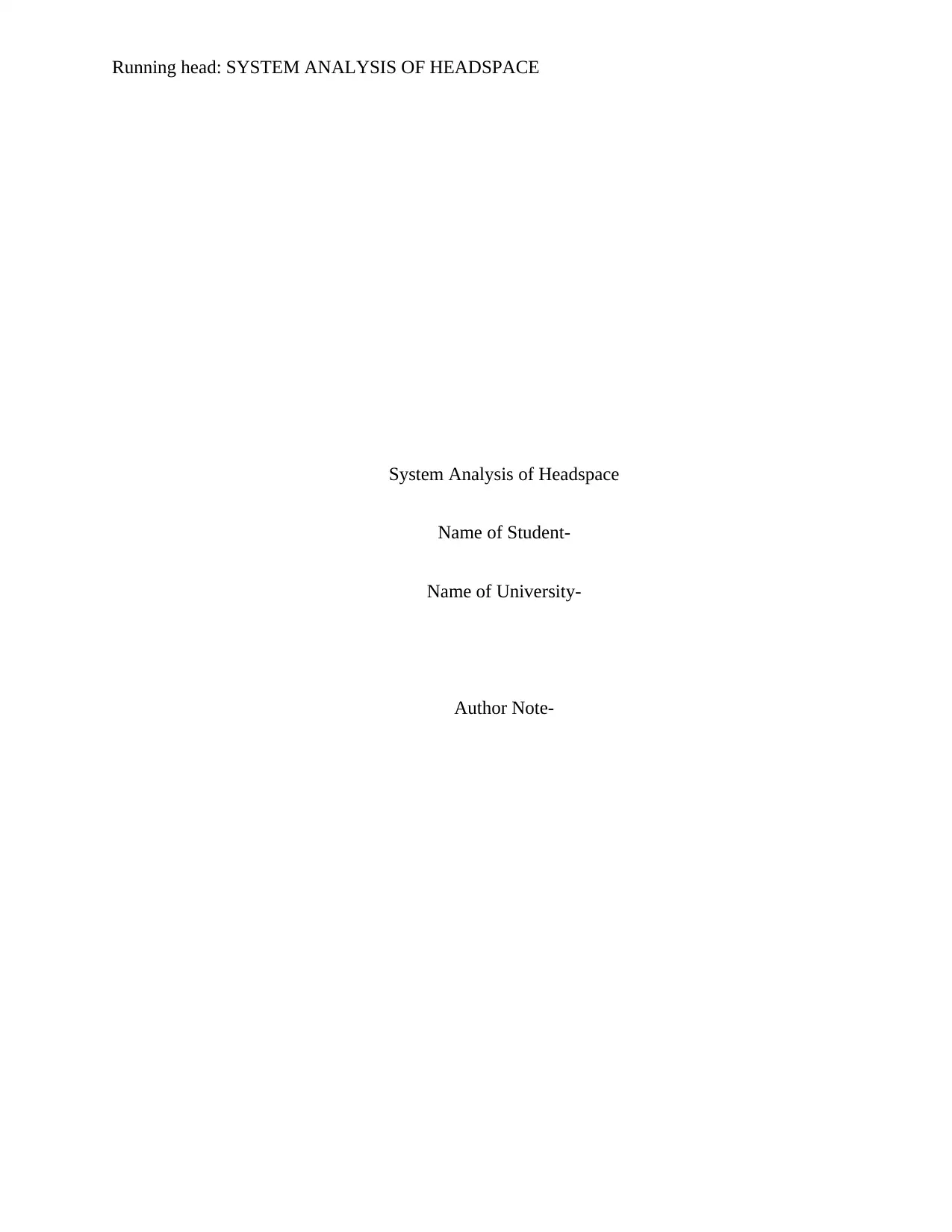
Running head: SYSTEM ANALYSIS OF HEADSPACE
System Analysis of Headspace
Name of Student-
Name of University-
Author Note-
System Analysis of Headspace
Name of Student-
Name of University-
Author Note-
Paraphrase This Document
Need a fresh take? Get an instant paraphrase of this document with our AI Paraphraser
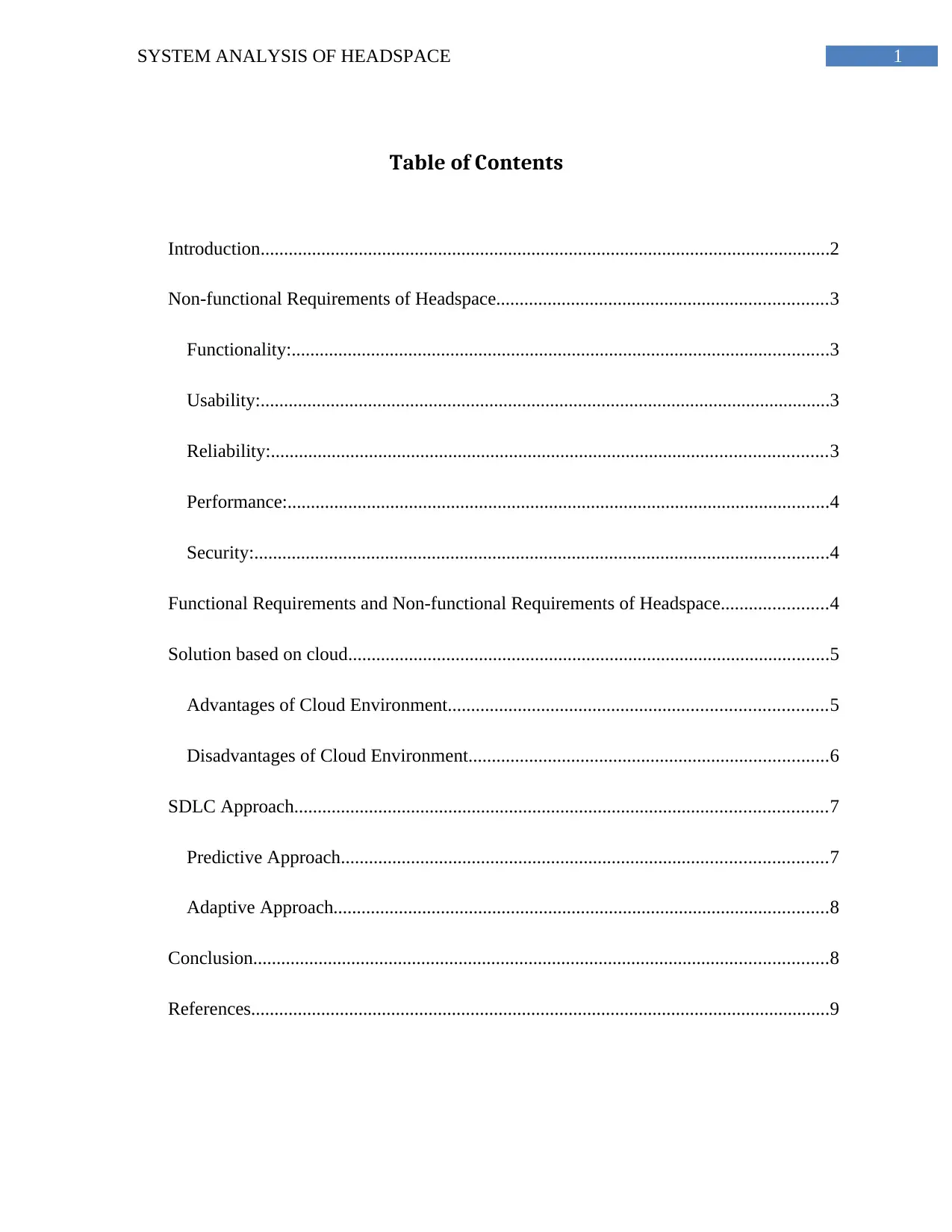
1SYSTEM ANALYSIS OF HEADSPACE
Table of Contents
Introduction..........................................................................................................................2
Non-functional Requirements of Headspace.......................................................................3
Functionality:...................................................................................................................3
Usability:..........................................................................................................................3
Reliability:.......................................................................................................................3
Performance:....................................................................................................................4
Security:...........................................................................................................................4
Functional Requirements and Non-functional Requirements of Headspace.......................4
Solution based on cloud.......................................................................................................5
Advantages of Cloud Environment.................................................................................5
Disadvantages of Cloud Environment.............................................................................6
SDLC Approach..................................................................................................................7
Predictive Approach........................................................................................................7
Adaptive Approach..........................................................................................................8
Conclusion...........................................................................................................................8
References............................................................................................................................9
Table of Contents
Introduction..........................................................................................................................2
Non-functional Requirements of Headspace.......................................................................3
Functionality:...................................................................................................................3
Usability:..........................................................................................................................3
Reliability:.......................................................................................................................3
Performance:....................................................................................................................4
Security:...........................................................................................................................4
Functional Requirements and Non-functional Requirements of Headspace.......................4
Solution based on cloud.......................................................................................................5
Advantages of Cloud Environment.................................................................................5
Disadvantages of Cloud Environment.............................................................................6
SDLC Approach..................................................................................................................7
Predictive Approach........................................................................................................7
Adaptive Approach..........................................................................................................8
Conclusion...........................................................................................................................8
References............................................................................................................................9
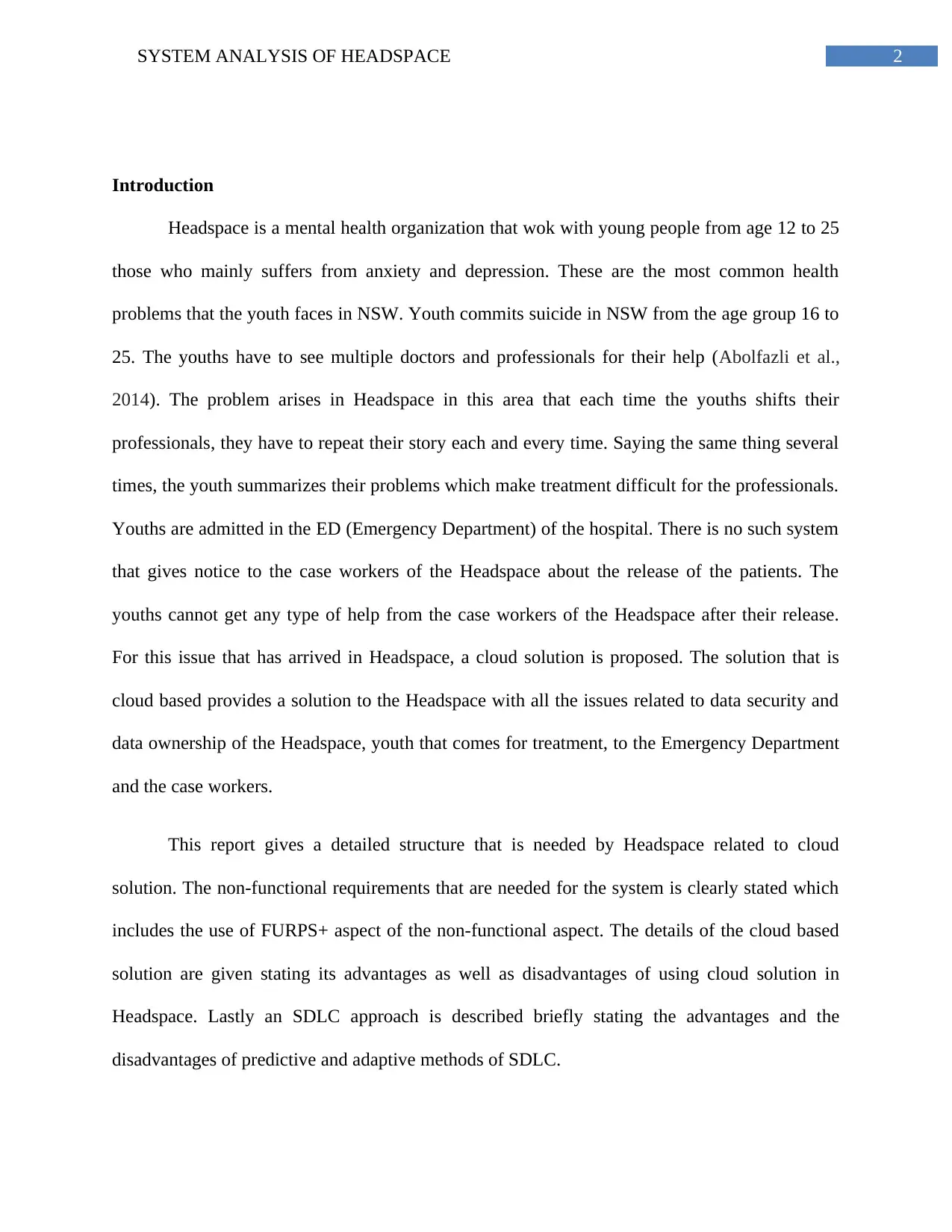
2SYSTEM ANALYSIS OF HEADSPACE
Introduction
Headspace is a mental health organization that wok with young people from age 12 to 25
those who mainly suffers from anxiety and depression. These are the most common health
problems that the youth faces in NSW. Youth commits suicide in NSW from the age group 16 to
25. The youths have to see multiple doctors and professionals for their help (Abolfazli et al.,
2014). The problem arises in Headspace in this area that each time the youths shifts their
professionals, they have to repeat their story each and every time. Saying the same thing several
times, the youth summarizes their problems which make treatment difficult for the professionals.
Youths are admitted in the ED (Emergency Department) of the hospital. There is no such system
that gives notice to the case workers of the Headspace about the release of the patients. The
youths cannot get any type of help from the case workers of the Headspace after their release.
For this issue that has arrived in Headspace, a cloud solution is proposed. The solution that is
cloud based provides a solution to the Headspace with all the issues related to data security and
data ownership of the Headspace, youth that comes for treatment, to the Emergency Department
and the case workers.
This report gives a detailed structure that is needed by Headspace related to cloud
solution. The non-functional requirements that are needed for the system is clearly stated which
includes the use of FURPS+ aspect of the non-functional aspect. The details of the cloud based
solution are given stating its advantages as well as disadvantages of using cloud solution in
Headspace. Lastly an SDLC approach is described briefly stating the advantages and the
disadvantages of predictive and adaptive methods of SDLC.
Introduction
Headspace is a mental health organization that wok with young people from age 12 to 25
those who mainly suffers from anxiety and depression. These are the most common health
problems that the youth faces in NSW. Youth commits suicide in NSW from the age group 16 to
25. The youths have to see multiple doctors and professionals for their help (Abolfazli et al.,
2014). The problem arises in Headspace in this area that each time the youths shifts their
professionals, they have to repeat their story each and every time. Saying the same thing several
times, the youth summarizes their problems which make treatment difficult for the professionals.
Youths are admitted in the ED (Emergency Department) of the hospital. There is no such system
that gives notice to the case workers of the Headspace about the release of the patients. The
youths cannot get any type of help from the case workers of the Headspace after their release.
For this issue that has arrived in Headspace, a cloud solution is proposed. The solution that is
cloud based provides a solution to the Headspace with all the issues related to data security and
data ownership of the Headspace, youth that comes for treatment, to the Emergency Department
and the case workers.
This report gives a detailed structure that is needed by Headspace related to cloud
solution. The non-functional requirements that are needed for the system is clearly stated which
includes the use of FURPS+ aspect of the non-functional aspect. The details of the cloud based
solution are given stating its advantages as well as disadvantages of using cloud solution in
Headspace. Lastly an SDLC approach is described briefly stating the advantages and the
disadvantages of predictive and adaptive methods of SDLC.
⊘ This is a preview!⊘
Do you want full access?
Subscribe today to unlock all pages.

Trusted by 1+ million students worldwide

3SYSTEM ANALYSIS OF HEADSPACE
Non-functional Requirements of Headspace
The requirements that are needed by Headspace to solve the different attributes of the
cloud based system are known as the non functional requirements of Headspace (Awan, Malik &
Javed, 2015). All the critical qualities of the cloud based system are recognized by the non-
functional requirements. The non-functional requirements of system are FURPS+. FURPS+
stands for functionality, usability, reliability, performance and the last is the security. The
requirements are important to a system of the Headspace. FURPS+ technique is explained in as
follows:
Functionality:
The Functionality defines the feature of a product that is considered as the most common
among all the features (Mijumbi et al., 2016). The functionality requirements are mostly
technical oriented which includes printing, auditing, system management, mail, licensing,
workflow and security.
Usability:
The issues that are related with the users are involved in usability of the FURPS+
technique. The issues are related with the user to start the system, look at all the requirements
and also capture the system (Rahimi et al., 2014). The non-functional requirements of the cloud
system are ensured by the usability factor of FURPS+.
Reliability:
Reliability ensures availability, accuracy and also recoverability. The dependency on the
recovery and the computations are the main factors that are related with the system which
protects the system from being shut down.
Non-functional Requirements of Headspace
The requirements that are needed by Headspace to solve the different attributes of the
cloud based system are known as the non functional requirements of Headspace (Awan, Malik &
Javed, 2015). All the critical qualities of the cloud based system are recognized by the non-
functional requirements. The non-functional requirements of system are FURPS+. FURPS+
stands for functionality, usability, reliability, performance and the last is the security. The
requirements are important to a system of the Headspace. FURPS+ technique is explained in as
follows:
Functionality:
The Functionality defines the feature of a product that is considered as the most common
among all the features (Mijumbi et al., 2016). The functionality requirements are mostly
technical oriented which includes printing, auditing, system management, mail, licensing,
workflow and security.
Usability:
The issues that are related with the users are involved in usability of the FURPS+
technique. The issues are related with the user to start the system, look at all the requirements
and also capture the system (Rahimi et al., 2014). The non-functional requirements of the cloud
system are ensured by the usability factor of FURPS+.
Reliability:
Reliability ensures availability, accuracy and also recoverability. The dependency on the
recovery and the computations are the main factors that are related with the system which
protects the system from being shut down.
Paraphrase This Document
Need a fresh take? Get an instant paraphrase of this document with our AI Paraphraser
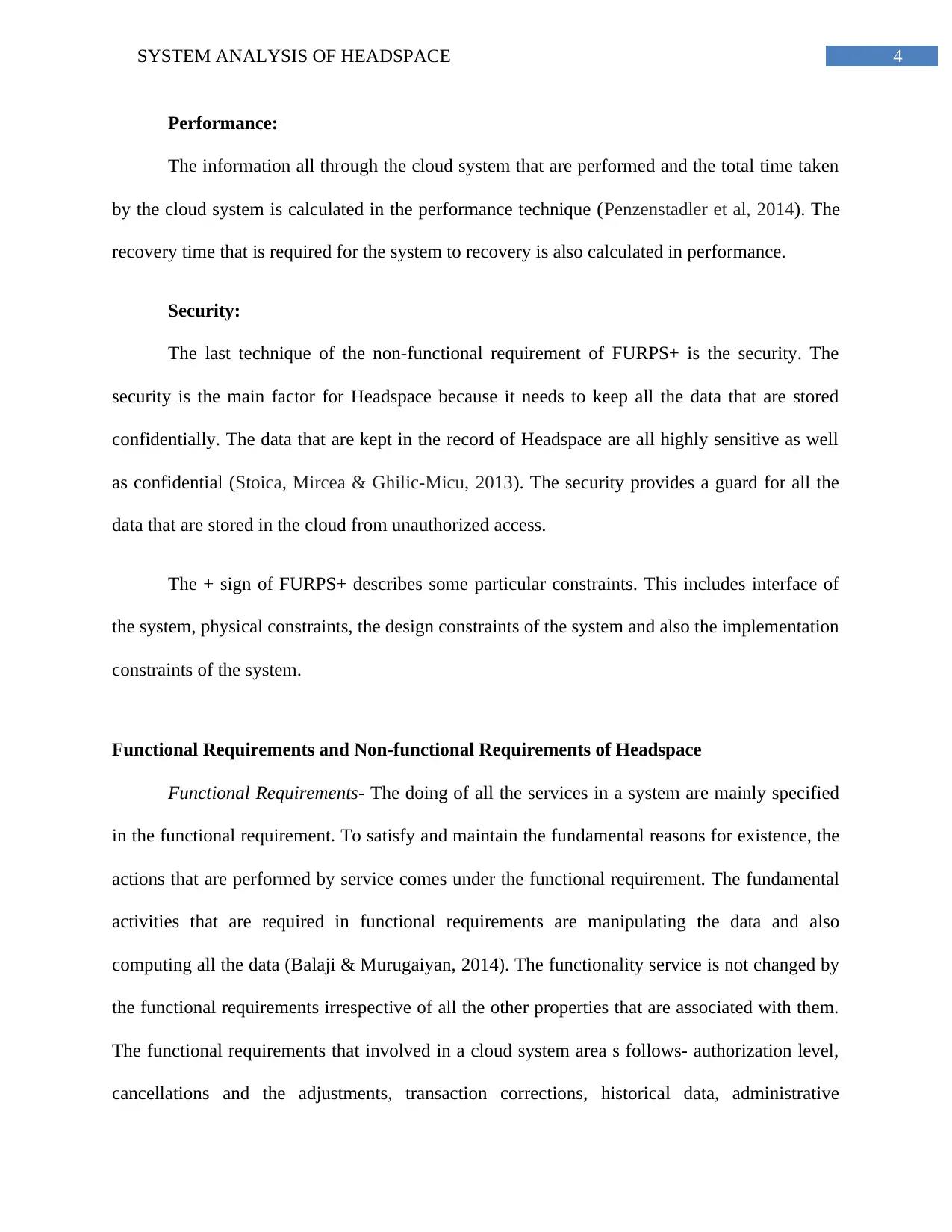
4SYSTEM ANALYSIS OF HEADSPACE
Performance:
The information all through the cloud system that are performed and the total time taken
by the cloud system is calculated in the performance technique (Penzenstadler et al, 2014). The
recovery time that is required for the system to recovery is also calculated in performance.
Security:
The last technique of the non-functional requirement of FURPS+ is the security. The
security is the main factor for Headspace because it needs to keep all the data that are stored
confidentially. The data that are kept in the record of Headspace are all highly sensitive as well
as confidential (Stoica, Mircea & Ghilic-Micu, 2013). The security provides a guard for all the
data that are stored in the cloud from unauthorized access.
The + sign of FURPS+ describes some particular constraints. This includes interface of
the system, physical constraints, the design constraints of the system and also the implementation
constraints of the system.
Functional Requirements and Non-functional Requirements of Headspace
Functional Requirements- The doing of all the services in a system are mainly specified
in the functional requirement. To satisfy and maintain the fundamental reasons for existence, the
actions that are performed by service comes under the functional requirement. The fundamental
activities that are required in functional requirements are manipulating the data and also
computing all the data (Balaji & Murugaiyan, 2014). The functionality service is not changed by
the functional requirements irrespective of all the other properties that are associated with them.
The functional requirements that involved in a cloud system area s follows- authorization level,
cancellations and the adjustments, transaction corrections, historical data, administrative
Performance:
The information all through the cloud system that are performed and the total time taken
by the cloud system is calculated in the performance technique (Penzenstadler et al, 2014). The
recovery time that is required for the system to recovery is also calculated in performance.
Security:
The last technique of the non-functional requirement of FURPS+ is the security. The
security is the main factor for Headspace because it needs to keep all the data that are stored
confidentially. The data that are kept in the record of Headspace are all highly sensitive as well
as confidential (Stoica, Mircea & Ghilic-Micu, 2013). The security provides a guard for all the
data that are stored in the cloud from unauthorized access.
The + sign of FURPS+ describes some particular constraints. This includes interface of
the system, physical constraints, the design constraints of the system and also the implementation
constraints of the system.
Functional Requirements and Non-functional Requirements of Headspace
Functional Requirements- The doing of all the services in a system are mainly specified
in the functional requirement. To satisfy and maintain the fundamental reasons for existence, the
actions that are performed by service comes under the functional requirement. The fundamental
activities that are required in functional requirements are manipulating the data and also
computing all the data (Balaji & Murugaiyan, 2014). The functionality service is not changed by
the functional requirements irrespective of all the other properties that are associated with them.
The functional requirements that involved in a cloud system area s follows- authorization level,
cancellations and the adjustments, transaction corrections, historical data, administrative

5SYSTEM ANALYSIS OF HEADSPACE
functions, certification requirements, business rules, requirements that are legal and regulatory,
external interfaces, reporting requirements, audit tracking and authentication. The most common
example of functional requirement is sending of email when new registration is done by the
customers or a customer sign in to their account.
Non-functional Requirements- The properties that are possessed by services comes under
the non-functional requirements of the cloud system (Chung et al., 2012). All the qualities and
the characteristics that are needed to make the cloud service fast, attractive, reliable and usable
are the properties of non-functional requirements. In non-functional requirement, fundamental
activities such as manipulation of data and computation of data are not at all required in the
system. The non-functional requirement of cloud service is made easy and secured for using by
adding different functionality. The limit of functionality is kept on the system in non-functional
requirements and the behavior is also elaborated in this requirement. The functions of non-
functional requirements that are involved in the cloud system are: capacity, reliability,
scalability, maintainability, regulatory, interoperability, usability, manageability, security,
performance of response time, utilization, static volumetric, availability, serviceability, data
integrity, recoverability and data integrity (Galibus & Vissia, 2015). All the attributes and the
characteristics of the cloud system are mentioned so that all the users accessing that database are
aware of the changed updated data.
Solution based on cloud
Advantages of Cloud Environment- The following are the advantages of cloud
environment.
functions, certification requirements, business rules, requirements that are legal and regulatory,
external interfaces, reporting requirements, audit tracking and authentication. The most common
example of functional requirement is sending of email when new registration is done by the
customers or a customer sign in to their account.
Non-functional Requirements- The properties that are possessed by services comes under
the non-functional requirements of the cloud system (Chung et al., 2012). All the qualities and
the characteristics that are needed to make the cloud service fast, attractive, reliable and usable
are the properties of non-functional requirements. In non-functional requirement, fundamental
activities such as manipulation of data and computation of data are not at all required in the
system. The non-functional requirement of cloud service is made easy and secured for using by
adding different functionality. The limit of functionality is kept on the system in non-functional
requirements and the behavior is also elaborated in this requirement. The functions of non-
functional requirements that are involved in the cloud system are: capacity, reliability,
scalability, maintainability, regulatory, interoperability, usability, manageability, security,
performance of response time, utilization, static volumetric, availability, serviceability, data
integrity, recoverability and data integrity (Galibus & Vissia, 2015). All the attributes and the
characteristics of the cloud system are mentioned so that all the users accessing that database are
aware of the changed updated data.
Solution based on cloud
Advantages of Cloud Environment- The following are the advantages of cloud
environment.
⊘ This is a preview!⊘
Do you want full access?
Subscribe today to unlock all pages.

Trusted by 1+ million students worldwide
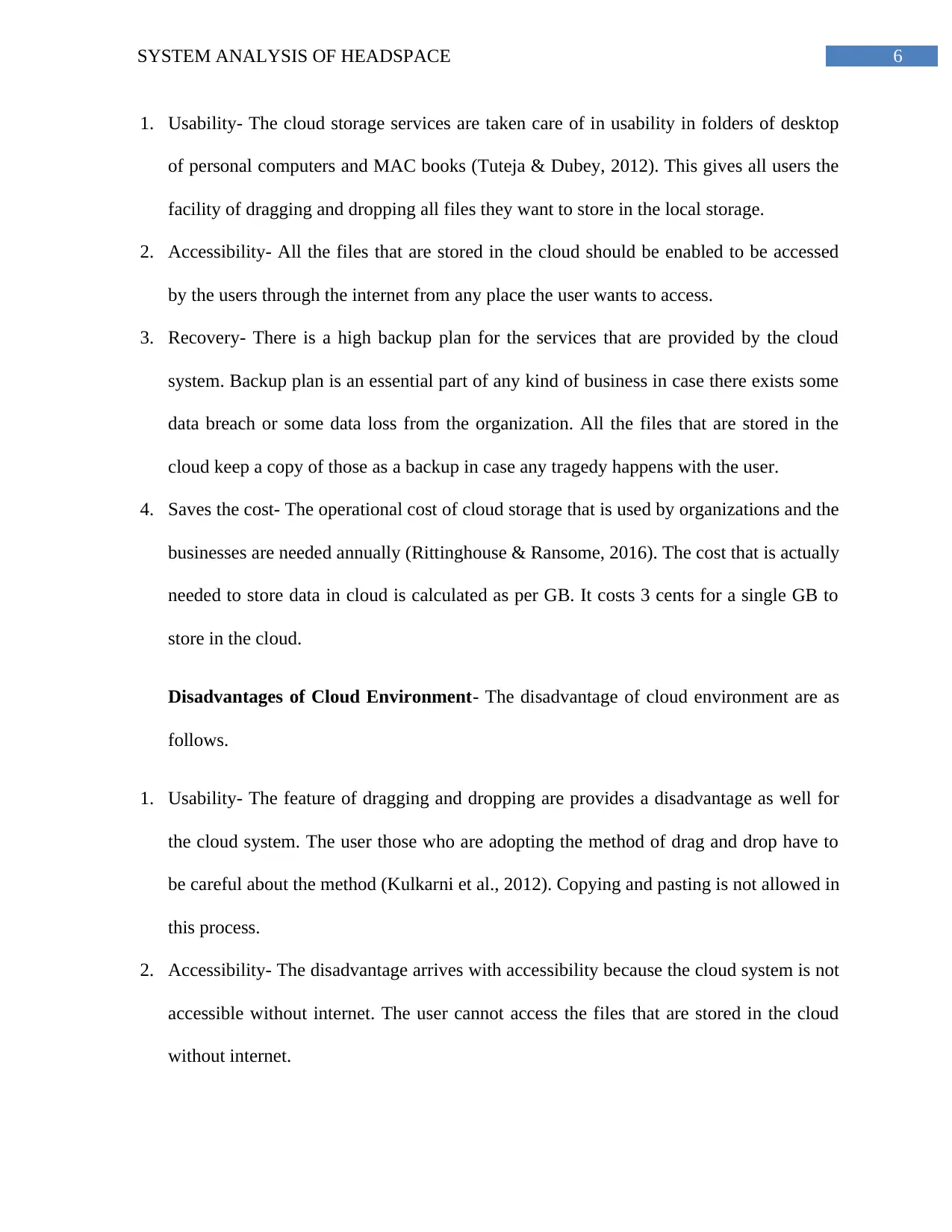
6SYSTEM ANALYSIS OF HEADSPACE
1. Usability- The cloud storage services are taken care of in usability in folders of desktop
of personal computers and MAC books (Tuteja & Dubey, 2012). This gives all users the
facility of dragging and dropping all files they want to store in the local storage.
2. Accessibility- All the files that are stored in the cloud should be enabled to be accessed
by the users through the internet from any place the user wants to access.
3. Recovery- There is a high backup plan for the services that are provided by the cloud
system. Backup plan is an essential part of any kind of business in case there exists some
data breach or some data loss from the organization. All the files that are stored in the
cloud keep a copy of those as a backup in case any tragedy happens with the user.
4. Saves the cost- The operational cost of cloud storage that is used by organizations and the
businesses are needed annually (Rittinghouse & Ransome, 2016). The cost that is actually
needed to store data in cloud is calculated as per GB. It costs 3 cents for a single GB to
store in the cloud.
Disadvantages of Cloud Environment- The disadvantage of cloud environment are as
follows.
1. Usability- The feature of dragging and dropping are provides a disadvantage as well for
the cloud system. The user those who are adopting the method of drag and drop have to
be careful about the method (Kulkarni et al., 2012). Copying and pasting is not allowed in
this process.
2. Accessibility- The disadvantage arrives with accessibility because the cloud system is not
accessible without internet. The user cannot access the files that are stored in the cloud
without internet.
1. Usability- The cloud storage services are taken care of in usability in folders of desktop
of personal computers and MAC books (Tuteja & Dubey, 2012). This gives all users the
facility of dragging and dropping all files they want to store in the local storage.
2. Accessibility- All the files that are stored in the cloud should be enabled to be accessed
by the users through the internet from any place the user wants to access.
3. Recovery- There is a high backup plan for the services that are provided by the cloud
system. Backup plan is an essential part of any kind of business in case there exists some
data breach or some data loss from the organization. All the files that are stored in the
cloud keep a copy of those as a backup in case any tragedy happens with the user.
4. Saves the cost- The operational cost of cloud storage that is used by organizations and the
businesses are needed annually (Rittinghouse & Ransome, 2016). The cost that is actually
needed to store data in cloud is calculated as per GB. It costs 3 cents for a single GB to
store in the cloud.
Disadvantages of Cloud Environment- The disadvantage of cloud environment are as
follows.
1. Usability- The feature of dragging and dropping are provides a disadvantage as well for
the cloud system. The user those who are adopting the method of drag and drop have to
be careful about the method (Kulkarni et al., 2012). Copying and pasting is not allowed in
this process.
2. Accessibility- The disadvantage arrives with accessibility because the cloud system is not
accessible without internet. The user cannot access the files that are stored in the cloud
without internet.
Paraphrase This Document
Need a fresh take? Get an instant paraphrase of this document with our AI Paraphraser
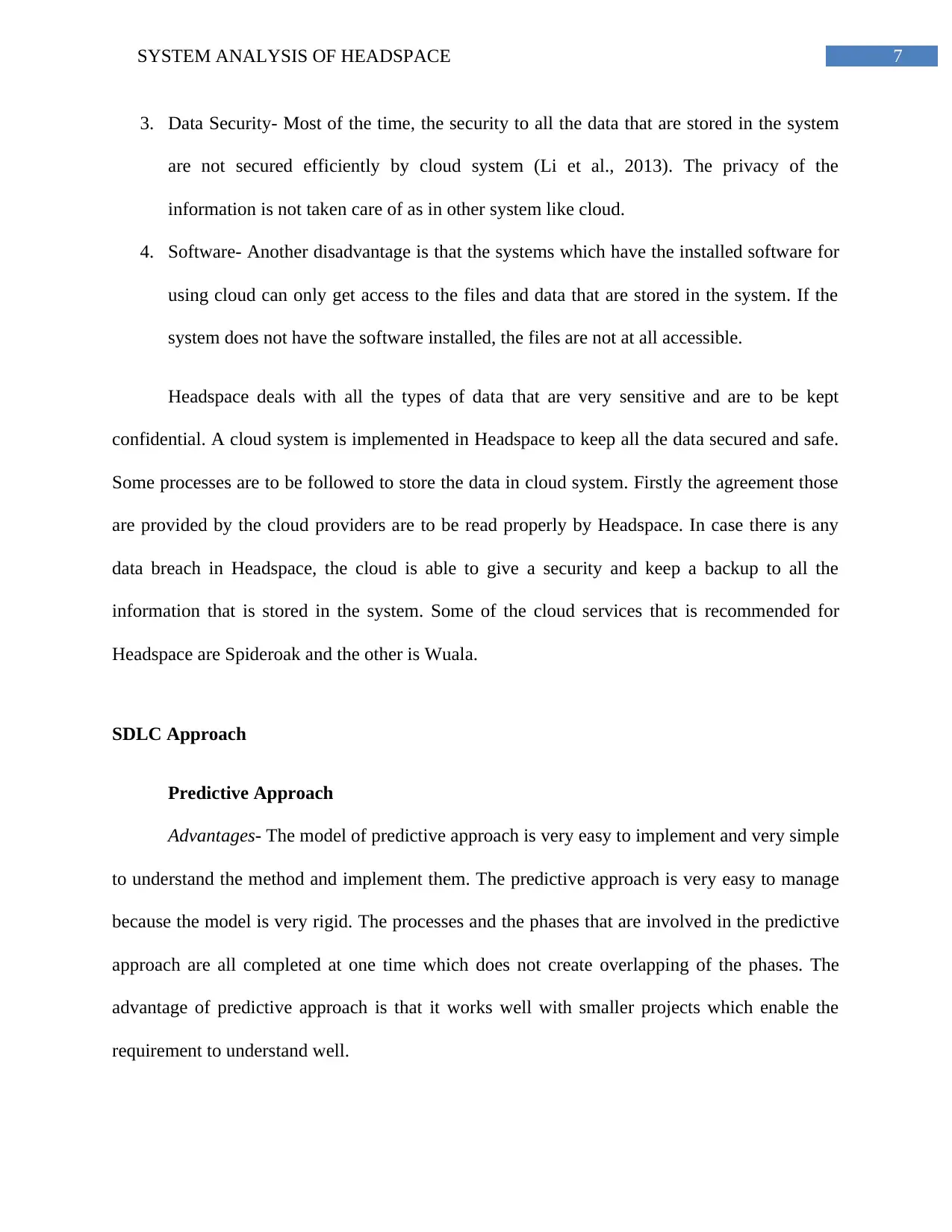
7SYSTEM ANALYSIS OF HEADSPACE
3. Data Security- Most of the time, the security to all the data that are stored in the system
are not secured efficiently by cloud system (Li et al., 2013). The privacy of the
information is not taken care of as in other system like cloud.
4. Software- Another disadvantage is that the systems which have the installed software for
using cloud can only get access to the files and data that are stored in the system. If the
system does not have the software installed, the files are not at all accessible.
Headspace deals with all the types of data that are very sensitive and are to be kept
confidential. A cloud system is implemented in Headspace to keep all the data secured and safe.
Some processes are to be followed to store the data in cloud system. Firstly the agreement those
are provided by the cloud providers are to be read properly by Headspace. In case there is any
data breach in Headspace, the cloud is able to give a security and keep a backup to all the
information that is stored in the system. Some of the cloud services that is recommended for
Headspace are Spideroak and the other is Wuala.
SDLC Approach
Predictive Approach
Advantages- The model of predictive approach is very easy to implement and very simple
to understand the method and implement them. The predictive approach is very easy to manage
because the model is very rigid. The processes and the phases that are involved in the predictive
approach are all completed at one time which does not create overlapping of the phases. The
advantage of predictive approach is that it works well with smaller projects which enable the
requirement to understand well.
3. Data Security- Most of the time, the security to all the data that are stored in the system
are not secured efficiently by cloud system (Li et al., 2013). The privacy of the
information is not taken care of as in other system like cloud.
4. Software- Another disadvantage is that the systems which have the installed software for
using cloud can only get access to the files and data that are stored in the system. If the
system does not have the software installed, the files are not at all accessible.
Headspace deals with all the types of data that are very sensitive and are to be kept
confidential. A cloud system is implemented in Headspace to keep all the data secured and safe.
Some processes are to be followed to store the data in cloud system. Firstly the agreement those
are provided by the cloud providers are to be read properly by Headspace. In case there is any
data breach in Headspace, the cloud is able to give a security and keep a backup to all the
information that is stored in the system. Some of the cloud services that is recommended for
Headspace are Spideroak and the other is Wuala.
SDLC Approach
Predictive Approach
Advantages- The model of predictive approach is very easy to implement and very simple
to understand the method and implement them. The predictive approach is very easy to manage
because the model is very rigid. The processes and the phases that are involved in the predictive
approach are all completed at one time which does not create overlapping of the phases. The
advantage of predictive approach is that it works well with smaller projects which enable the
requirement to understand well.

8SYSTEM ANALYSIS OF HEADSPACE
Disadvantages- The disadvantage predictive approach is that if the user proceeds with the
method once, then the user feels difficult to go back if the processes reach to its testing stage.
The projects that are done with this method are mostly very complex and are object oriented
(AlZain et al., 2012). This model provides high uncertainty and also is risky to be carried out.
The main disadvantage of predictive approach is that they do not work with a project that runs
long.
Adaptive Approach
Advantages of adaptive model- The functions that are involved in the adaptive model can
be developed early before implementing the process. The results that come from this method can
also be predicted before the completion of the project. Planning process is done for this adaptive
method.
Disadvantages of adaptive model- The adaptive method requires many processes which
prove a disadvantage of this model. Managing the adaptive method is very difficult as it deals
with big projects and methods. For defining the increments, the complete system are to be
defined beforehand which is very difficult.
Conclusion
Headspace can use the SDLC Adaptive method for completing their processes
because the functions that are involved in the adaptive model can be developed early before
implementing the process. The results that come from this method can also be predicted before
the completion of the project. Planning process is done for this adaptive method. The
requirements that are needed by Headspace to solve the different attributes of the cloud based
system are known as the non functional requirements of Headspace. All the critical qualities of
Disadvantages- The disadvantage predictive approach is that if the user proceeds with the
method once, then the user feels difficult to go back if the processes reach to its testing stage.
The projects that are done with this method are mostly very complex and are object oriented
(AlZain et al., 2012). This model provides high uncertainty and also is risky to be carried out.
The main disadvantage of predictive approach is that they do not work with a project that runs
long.
Adaptive Approach
Advantages of adaptive model- The functions that are involved in the adaptive model can
be developed early before implementing the process. The results that come from this method can
also be predicted before the completion of the project. Planning process is done for this adaptive
method.
Disadvantages of adaptive model- The adaptive method requires many processes which
prove a disadvantage of this model. Managing the adaptive method is very difficult as it deals
with big projects and methods. For defining the increments, the complete system are to be
defined beforehand which is very difficult.
Conclusion
Headspace can use the SDLC Adaptive method for completing their processes
because the functions that are involved in the adaptive model can be developed early before
implementing the process. The results that come from this method can also be predicted before
the completion of the project. Planning process is done for this adaptive method. The
requirements that are needed by Headspace to solve the different attributes of the cloud based
system are known as the non functional requirements of Headspace. All the critical qualities of
⊘ This is a preview!⊘
Do you want full access?
Subscribe today to unlock all pages.

Trusted by 1+ million students worldwide
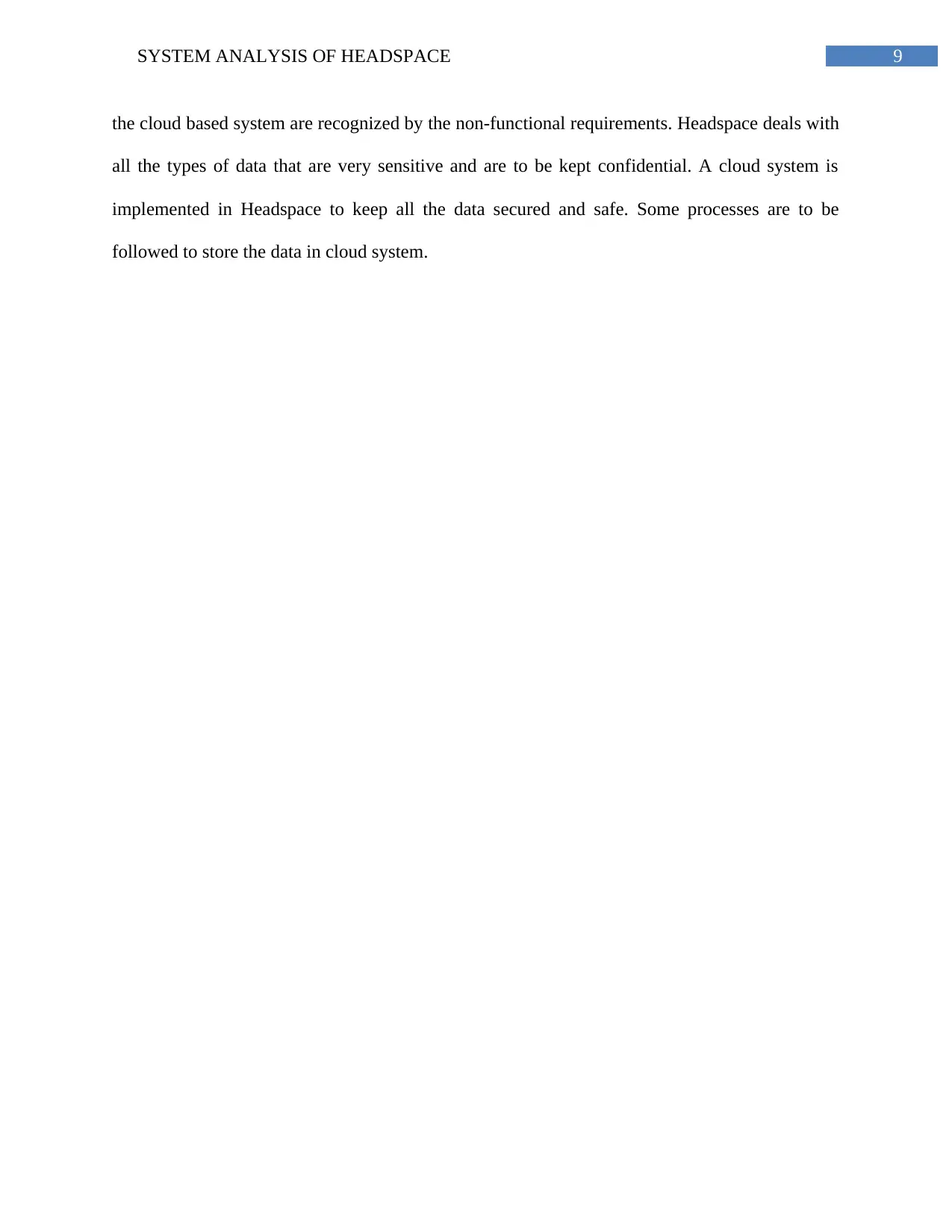
9SYSTEM ANALYSIS OF HEADSPACE
the cloud based system are recognized by the non-functional requirements. Headspace deals with
all the types of data that are very sensitive and are to be kept confidential. A cloud system is
implemented in Headspace to keep all the data secured and safe. Some processes are to be
followed to store the data in cloud system.
the cloud based system are recognized by the non-functional requirements. Headspace deals with
all the types of data that are very sensitive and are to be kept confidential. A cloud system is
implemented in Headspace to keep all the data secured and safe. Some processes are to be
followed to store the data in cloud system.
Paraphrase This Document
Need a fresh take? Get an instant paraphrase of this document with our AI Paraphraser
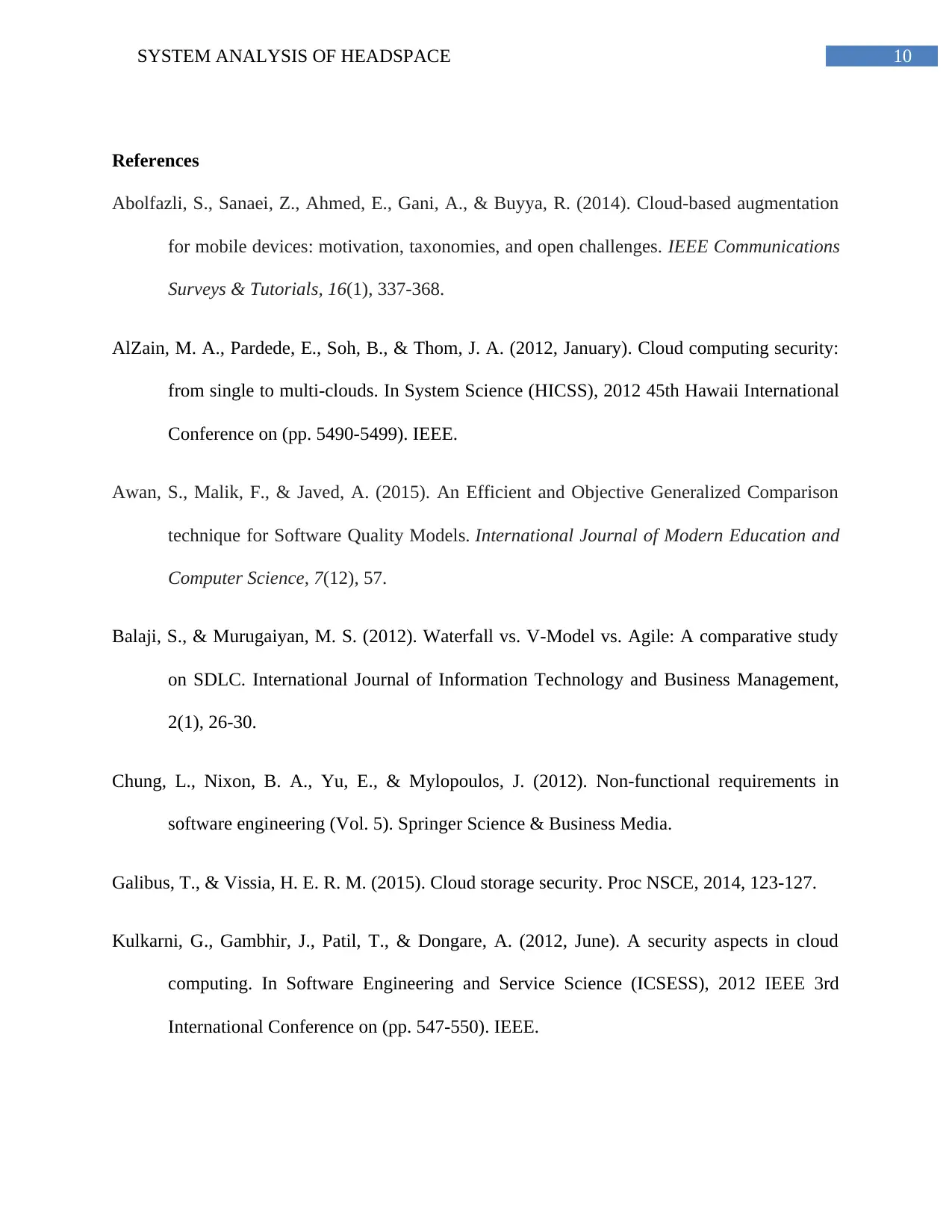
10SYSTEM ANALYSIS OF HEADSPACE
References
Abolfazli, S., Sanaei, Z., Ahmed, E., Gani, A., & Buyya, R. (2014). Cloud-based augmentation
for mobile devices: motivation, taxonomies, and open challenges. IEEE Communications
Surveys & Tutorials, 16(1), 337-368.
AlZain, M. A., Pardede, E., Soh, B., & Thom, J. A. (2012, January). Cloud computing security:
from single to multi-clouds. In System Science (HICSS), 2012 45th Hawaii International
Conference on (pp. 5490-5499). IEEE.
Awan, S., Malik, F., & Javed, A. (2015). An Efficient and Objective Generalized Comparison
technique for Software Quality Models. International Journal of Modern Education and
Computer Science, 7(12), 57.
Balaji, S., & Murugaiyan, M. S. (2012). Waterfall vs. V-Model vs. Agile: A comparative study
on SDLC. International Journal of Information Technology and Business Management,
2(1), 26-30.
Chung, L., Nixon, B. A., Yu, E., & Mylopoulos, J. (2012). Non-functional requirements in
software engineering (Vol. 5). Springer Science & Business Media.
Galibus, T., & Vissia, H. E. R. M. (2015). Cloud storage security. Proc NSCE, 2014, 123-127.
Kulkarni, G., Gambhir, J., Patil, T., & Dongare, A. (2012, June). A security aspects in cloud
computing. In Software Engineering and Service Science (ICSESS), 2012 IEEE 3rd
International Conference on (pp. 547-550). IEEE.
References
Abolfazli, S., Sanaei, Z., Ahmed, E., Gani, A., & Buyya, R. (2014). Cloud-based augmentation
for mobile devices: motivation, taxonomies, and open challenges. IEEE Communications
Surveys & Tutorials, 16(1), 337-368.
AlZain, M. A., Pardede, E., Soh, B., & Thom, J. A. (2012, January). Cloud computing security:
from single to multi-clouds. In System Science (HICSS), 2012 45th Hawaii International
Conference on (pp. 5490-5499). IEEE.
Awan, S., Malik, F., & Javed, A. (2015). An Efficient and Objective Generalized Comparison
technique for Software Quality Models. International Journal of Modern Education and
Computer Science, 7(12), 57.
Balaji, S., & Murugaiyan, M. S. (2012). Waterfall vs. V-Model vs. Agile: A comparative study
on SDLC. International Journal of Information Technology and Business Management,
2(1), 26-30.
Chung, L., Nixon, B. A., Yu, E., & Mylopoulos, J. (2012). Non-functional requirements in
software engineering (Vol. 5). Springer Science & Business Media.
Galibus, T., & Vissia, H. E. R. M. (2015). Cloud storage security. Proc NSCE, 2014, 123-127.
Kulkarni, G., Gambhir, J., Patil, T., & Dongare, A. (2012, June). A security aspects in cloud
computing. In Software Engineering and Service Science (ICSESS), 2012 IEEE 3rd
International Conference on (pp. 547-550). IEEE.
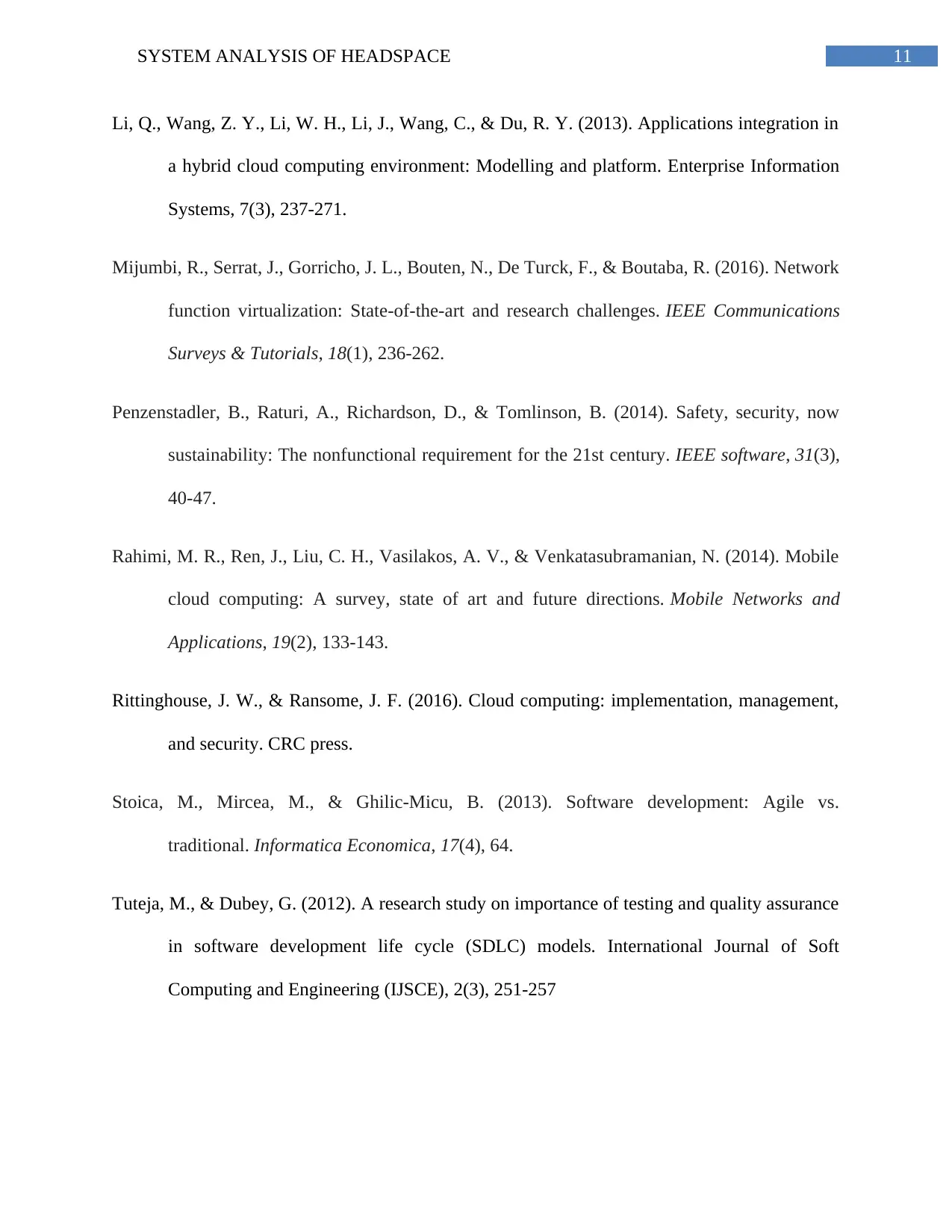
11SYSTEM ANALYSIS OF HEADSPACE
Li, Q., Wang, Z. Y., Li, W. H., Li, J., Wang, C., & Du, R. Y. (2013). Applications integration in
a hybrid cloud computing environment: Modelling and platform. Enterprise Information
Systems, 7(3), 237-271.
Mijumbi, R., Serrat, J., Gorricho, J. L., Bouten, N., De Turck, F., & Boutaba, R. (2016). Network
function virtualization: State-of-the-art and research challenges. IEEE Communications
Surveys & Tutorials, 18(1), 236-262.
Penzenstadler, B., Raturi, A., Richardson, D., & Tomlinson, B. (2014). Safety, security, now
sustainability: The nonfunctional requirement for the 21st century. IEEE software, 31(3),
40-47.
Rahimi, M. R., Ren, J., Liu, C. H., Vasilakos, A. V., & Venkatasubramanian, N. (2014). Mobile
cloud computing: A survey, state of art and future directions. Mobile Networks and
Applications, 19(2), 133-143.
Rittinghouse, J. W., & Ransome, J. F. (2016). Cloud computing: implementation, management,
and security. CRC press.
Stoica, M., Mircea, M., & Ghilic-Micu, B. (2013). Software development: Agile vs.
traditional. Informatica Economica, 17(4), 64.
Tuteja, M., & Dubey, G. (2012). A research study on importance of testing and quality assurance
in software development life cycle (SDLC) models. International Journal of Soft
Computing and Engineering (IJSCE), 2(3), 251-257
Li, Q., Wang, Z. Y., Li, W. H., Li, J., Wang, C., & Du, R. Y. (2013). Applications integration in
a hybrid cloud computing environment: Modelling and platform. Enterprise Information
Systems, 7(3), 237-271.
Mijumbi, R., Serrat, J., Gorricho, J. L., Bouten, N., De Turck, F., & Boutaba, R. (2016). Network
function virtualization: State-of-the-art and research challenges. IEEE Communications
Surveys & Tutorials, 18(1), 236-262.
Penzenstadler, B., Raturi, A., Richardson, D., & Tomlinson, B. (2014). Safety, security, now
sustainability: The nonfunctional requirement for the 21st century. IEEE software, 31(3),
40-47.
Rahimi, M. R., Ren, J., Liu, C. H., Vasilakos, A. V., & Venkatasubramanian, N. (2014). Mobile
cloud computing: A survey, state of art and future directions. Mobile Networks and
Applications, 19(2), 133-143.
Rittinghouse, J. W., & Ransome, J. F. (2016). Cloud computing: implementation, management,
and security. CRC press.
Stoica, M., Mircea, M., & Ghilic-Micu, B. (2013). Software development: Agile vs.
traditional. Informatica Economica, 17(4), 64.
Tuteja, M., & Dubey, G. (2012). A research study on importance of testing and quality assurance
in software development life cycle (SDLC) models. International Journal of Soft
Computing and Engineering (IJSCE), 2(3), 251-257
⊘ This is a preview!⊘
Do you want full access?
Subscribe today to unlock all pages.

Trusted by 1+ million students worldwide
1 out of 12
Related Documents
Your All-in-One AI-Powered Toolkit for Academic Success.
+13062052269
info@desklib.com
Available 24*7 on WhatsApp / Email
![[object Object]](/_next/static/media/star-bottom.7253800d.svg)
Unlock your academic potential
Copyright © 2020–2025 A2Z Services. All Rights Reserved. Developed and managed by ZUCOL.





